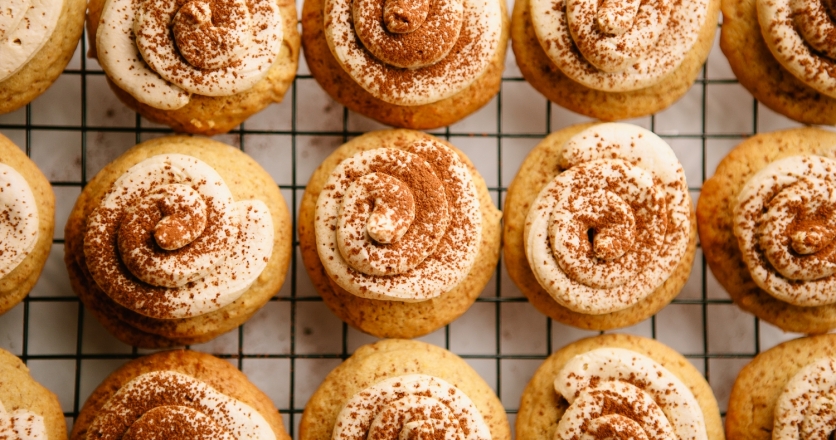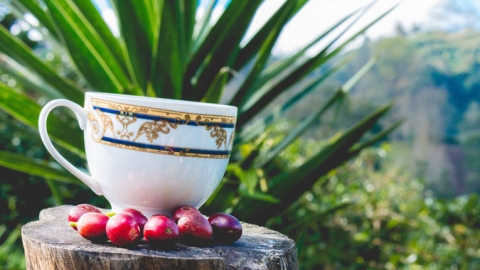In-season: Coffee
Whether we sip from our morning mug of coffee for the rush of caffeine or simply to enjoy the flavor, our culture has become obsessed with coffee. It’s often referred to as “liquid gold”—mostly for brewed coffee's dose of caffeine, but also for its treasured journey from farm to cup, with exciting flavor profiles emerging from different regions based on climate, altitude and soil. It has inspired us to try blends from all over the world and to brew them in myriad ways with our vast collections of coffee gadgets. We may even attempt to roast the beans ourselves.
Although coffee is roasted, brewed and enjoyed in homes and coffee shops all over the Michiana region, it is not grown or cultivated in the area. Coffee beans are the seeds of the Coffea plant’s fruit, which grows in tropical countries along the equator. The fruit is often called a “coffee cherry” for its bright red cherry-like appearance.
Coffee beans are green and have a grassy aroma before they go through the roasting process. Each region where the coffee plants are grown produces a unique flavor profile. The flavors range in levels of acidity, complexity, fruitiness and earthiness and may contain notes of chocolate, spice, berry, caramel and more.
There are four main coffee bean varieties: arabica, robusta, liberica and excelsa. Arabica comes in first place as the most widely consumed coffee bean in the world, with robusta coming in second.
Arabica beans are loved for their delicate, smooth, sweet notes; however, they are incredibly diverse, with an infinite number of flavor profiles. They are grown in regions of Latin America, Asia and East Africa.
Robusta beans are known for their more robust and intense flavors, with an even higher caffeine kick and bitter aftertaste. They are primarily grown in Indonesia, Vietnam and Africa and are most often used in instant coffee and espresso blends because of their robust flavor profiles.
While liberica and excelsa are harder to find in the coffee aisle, their unique characteristics make them valuable in blends to add complexity to the finished product.
Selecting:
Factors to consider for selecting the perfect coffee bean include your personal taste, the roasting process, geographic origins, caffeine levels, bean varieties and the equipment you will use to brew the beans. Don’t be afraid to experiment to find the best match; ask your local barista or coffee roaster about their available varieties and the best way to enjoy them.
You’ll often see beans labeled “single-origin” or “blend.” Single-origin coffee comes from plants harvested from a specific country or region, most often Arabica varieties. The unique growing conditions make for an exceptional and pure flavor profile. Blends consist of beans from a series of geographical locations and are blended to suit flavor preferences.
Beans that are roasted the longest are labeled “dark roast” and will have deep flavors, less caffeine and less acidity. Dark roast is perfect for making cold brews and espresso-based drinks. Medium roast coffees are the most popular because of their well-rounded flavors and balanced acidity. Medium roasts are perfect for any brew, from espresso to pour-overs. Light roast coffee will have the highest acidity and caffeine content as well as flavors closest to the bean’s original characteristics. Because of this, lightly roasted beans are best for pour-over or drip coffee.
Storing:
Coffee beans are porous and can easily absorb aromas, so store them away from other spices or strong-smelling foods. To keep coffee beans as fresh as possible, store them at room temperature in a tightly sealed package, away from extreme temperatures or direct sunlight. Ground coffee beans will lose their aroma and flavor more quickly than whole coffee beans. Storing beans whole and grinding them for each use is the best way to prolong their shelf life. Whole coffee beans can be stored for up to a year in a tightly sealed package. Once opened, consume within 2 to 3 weeks. Ground coffee beans can be stored for around 6 months in a tightly sealed package and should be consumed within 1 to 2 weeks once opened. A good rule of thumb is to consume your beans as soon as possible for the best flavor.
Pairing:
Alliums, allspice, apples, avocados, beans, beef, beer, beets, berries, bread, butter, cardamom, carrots, celery, cheese, chilis, chocolate, cilantro, cinnamon, cloves, coconut, corn, cream, cumin, eggs, fennel, fish, ginger, grains, grapefruit, honey, lemon, lettuce, lime, mango, maple syrup, milk, mint, mushrooms, mustard, nuts, olives, orange, oregano, peppers, pork, potatoes, poultry, rosemary, sage, salt, sesame, spinach, squash, stone fruit, sugar, sweet potatoes, tea, thyme, tomatoes, vanilla, vinegar, wheat.
Ashley Swartzendruber is Edible Michiana’s recipe editor, stylist and photographer based in Goshen, Indiana. She can be found cooking, eating and photographing local food in her home or exploring Michiana with her family. You can find more of her photos, styling and motherhood musings on her Instagram @mywildhaven.






